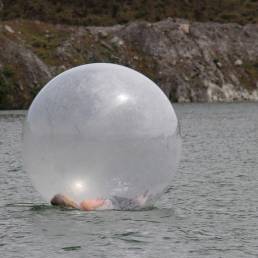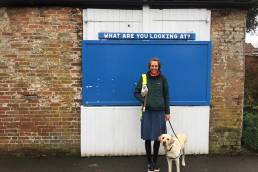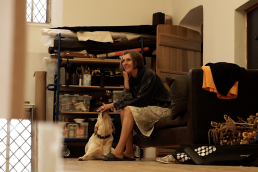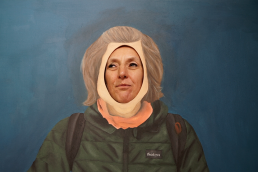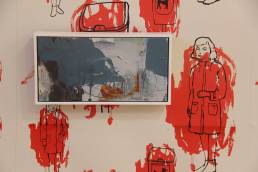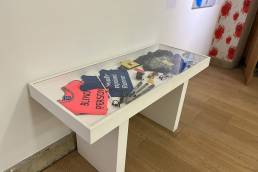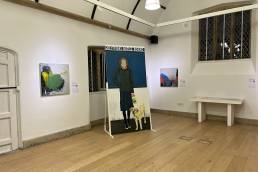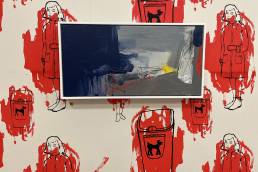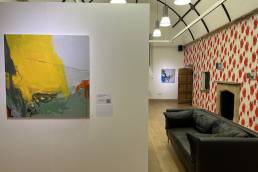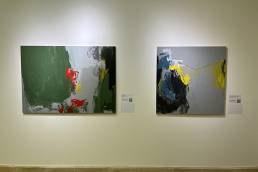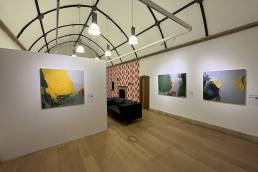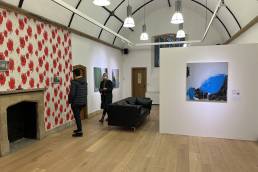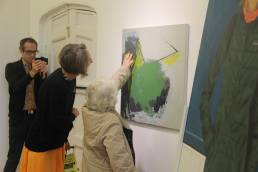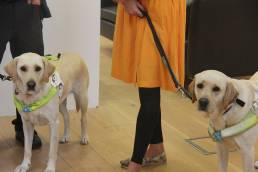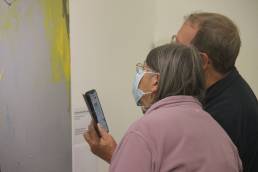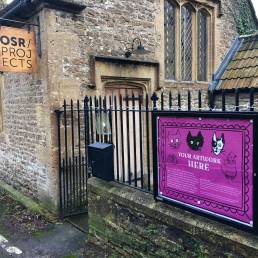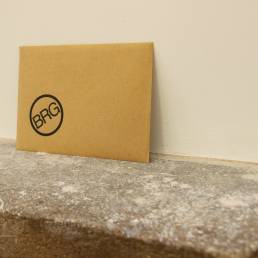What are you looking at?
15 October – 7 November 2021
An exhibition of new work by artist Angela Charles exploring notions of ‘seeing’ in art from the perspective of a visually impaired painter (with gerbil coloured hair).
Since graduating from Goldsmiths in 1989, Angela Charles (also known as Angela Blackwell) has had parallel careers as an award winning Curator and Visual Artist. From regular shows in St Ives to commissions for a high profile exhibition in Milan, Angela has achieved commercial success with her paintings drawn from her memories of place.
And yet, unbeknown to purchasers of her work and the galleries that represent her, for the last eleven years Angela has been losing her sight. Angela has felt alone with what she refers to as her ‘guilty secret’ still painting and exhibiting whilst denying the existence of her blindness (and her guide dog) to buyers and galleries.
“This project marks a crucial period of transition in my artistic practice whilst I adapt to my sight loss.”
During the summer of 2021 Angela had been using OSR Projects as a studio in advance of the exhibition this Autumn. A brighter palette and bolder mark making are features of a new series of paintings directly relating to previous work in style and form. These new works look at the elements of everyday life that disable her, her life growing up in a seaside town and her new challenges of coming out as a blind painter.
Angela was also working closely with filmmaker Liberty Smith on a documentary film. With openness and humour, the film reveals a fresh perspective on the challenging process of opening up to a critical peer network about what it is like to lose your sight as a visual artist.
What are you looking at?
The exhibition was funded by Arts Council England (ACE) and supported by South Somerset District Council (SSDC).


What are you looking at? Exhibition by Angela Charles
Alistair Gentry, October 2021
The first impression of visiting Angela Charles at her exhibition at OSR projects is relief that somebody has finally staged an exhibition of paintings that doesn’t look like a sterile showroom for lifestyle accessories, or a dingy Victorian museum. That this is an exhibition by a visually impaired artist is not second but definitely somewhere in the top ten impressions, and this is clearly a conscious and deeply thought-through decision.
Angela’s slightly anarchic guide dog is maybe not as much of a giveaway as you might think, to some people anyway; Angela recalls being asked if she’s training her dog for somebody else because she “doesn’t look blind.” Daft comments like this are pretty much a daily reality for anyone with a sensory impairment, but the artist has decided to refute them en masse and essentially come out of the closet after over a decade of losing her vision while actively concealing it from buyers of her paintings and galleries that were representing her. If this seems a weird and possibly impossible thing to hide, remember the aforementioned ubiquity of “you don’t look it…” then think for a moment about all the cruel jokes or lazy reviews that more or less write themselves when you read the words “blind painter.” And if that doesn’t get you inside the head of a visual artist who was losing the ability to see colour and the medium she works in but didn’t want anybody to know, think about the person who told Angela that if they lost their sight they’d probably consider suicide, which is not just gauche but actually a ghastly thing to say to anyone, let alone a disabled or impaired person. “Why haven’t you killed yourself?”
Now that she’s outed herself as visually impaired, she’s free to make this exhibition that suggest being visually impaired could be an aesthetic instead of an impairment. She notes in the beautifully made and involving companion film about her and her work by Liberty Smith that “visually impaired” is what we’re mostly calling people like her now, rather than the more blunt (and often not even factually correct) blind. There’s a sly reminder near the gallery entrance of the dodgy history of stigmatising disability nomenclature in the form of one of those fibreglass statues with a slot in their head for money. People who were alive in the Eighties, Seventies or Sixties will remember the ubiquity of these figures as street furniture– usually blonde girls– with various impairments and emblazoned with phrases like BLIND PLEASE HELP. I still remember vividly the dejected girl with her peeling paint outside the village post office. She had a blue dress and a leg brace, and she was holding a box that said HELP SPASTICS in massive crimson capitals. Me and my brother, aged probably eight and six, used to ask our mum if we could get 10p “for the spastics.”
The respectful term nowadays is cerebral palsy, the Spastics Society is now Scope, and the blonde blind girl has been sacked and replaced by a blonde dog with another smaller dog at her feet. But the modern incarnations of that fibreglass girl are still here to collect coins through their craniums, a reminder that real disabled people in the 21st century still often rely on charity and other people’s largesse for the basic rights and comforts that should be everybody’s. Whether their disabilities (or rather, the ways in which society disables them) are visible to others or not, people who weren’t previously regarded as disabled or impaired are perhaps more acutely aware of the humiliations and aggravations that start to accumulate daily because they have memories like these; of pitying disabled people, perhaps even an unspoken– or worse, loudly and thoughtlessly spoken– conviction that they’d rather be dead than disabled.
Everywhere else in the exhibition there’s a similar darkly funny approach to full disclosure of what it means to find oneself, unexpectedly and irreversibly, the girl with the coin slot in her head. A glass cabinet has a slightly more depressing than hilarious array of what I can only call blind person accessories, including those huge black NASA glasses you’d wear if you were watching a rocket take off or were playing a blind person in an un-PC comedy sketch. It’s also hard to imagine that anyone fully thought through how shit it would feel if you had to wear a fluorescent pink tabard with the phrase BLIND PERSON on it in four inch high letters. Many assistive technologies are transformative for sensory impaired or disabled people, but there are also examples here of the disability assistance industry’s consistently shonky or just-good-enough design. A pair of glasses that appear to have been purposely designed to make an already anxious and stressed visually impaired person look like something from a Terry Gilliam film are not only ugly but were also given to Angela with a suitably Pythonesque warning not to use them too much or they would damage her eyesight. Memorable absurdities like this also make an appearance in a wallpaper design recalling Angela’s attempt to deposit a plastic bag of her guide dog’s crap into what she thought was a poo bin but turned out to be an understandably alarmed woman wearing a bright red coat.
The abstract paintings themselves vary in size and proportion but all share unique relations of colour that make this a cohesive show. Discussing them with the artist in with regard to her loss and change of vision– the shifting of colour perception, a different sense of what constitutes contrast or compliment, an impression of part of the visual field being washed out or gone, memories of colour versus what she sees versus the objective fact of what her smartphone reads out from the side of a tube of paint– it’s really obvious that they’re the considered and deliberate work, at the same time, of an artist embracing visual impairment as in some way a part of her practice but also functioning as an artist without any kind of prefix.
In addition to Braille descriptions, each painting has an audio description. These are a mischievously mixed bag. Some would pass muster as straight audio description and might even enable a person to recreate the painting without seeing it. There’s also, for example, a rambling, overlapping collaboration by two girls who seem mainly determined to work out what is and is not pretty in their assigned image. My favourite, and I’m casting no aspersions here, is what sounds like a mature and sensible woman apparently reimagining her view of a small abstract painting as a bong-adjacent contemplation of a trippy prog rock album or a seventies sci fi novel cover. Huge turquoise space ships are involved.
Listening to the wildly differing interpretations of the paintings here, I’m reminded that our physical eyes are only doing some of the work of seeing. Both physiologically, linguistically and metaphorically, our brains are doing most of our visual processing. In fact when our visual hardware degrades or fails our brains often keep going as best they can to provide us with the visual input we’re designed for. Your brain will make up that input from scratch if it has to, and then you’re definitely into turquoise space ships territory for real. A blind artist is not a contradiction. A blind artist is potentially even an upgrade. Out of the context of this exhibition, you start to understand that it’s completely conceivable for somebody to look at art works like these, curate them, buy them without knowing or guessing that the artist is visually impaired. The artist could hide her impairment, and she did, but she’s choosing not to do that any more. And that’s powerful.
View and listen to some of amazing interviews Angela has had with the RNIB, BBC Radio Somerset, BBC Points West, local press, Western Gazett, Marshwood Vale magazine and Evolver magazine.
Angela Charles talks to Seth Dellow, Marshwood Vale Magazine
Past, Present and Future Angela Charles feature in Marshwood Vale Magazine
Listen to Angela talking art and life with the RNIB Connect radio
BBC Radio Somerset, Angela talks to Will Richards
Angela on BBC Points West 4/11/21
Related Projects
Weather Station (Part 2)
Project
Exhibition,Publication
